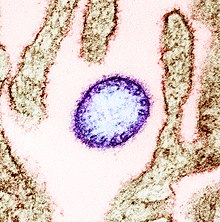Nipah Virus- Understanding the disease and its management
Nipah virus infection is a Zoonotic infection (it can be transmitted from animals to humans) caused by a virus. The first case of the disease was identified in 1998/99 in Malaysia when an outbreak occurred on pig farms which included symptoms covering neurological and respiratory diseases and caused around 300 human deaths. The virus was isolated in 1999. The disease gets its name ‘Nipah” from the place it was identified i.e. Sungai Nipah in Port Dickson District, Negeri Sembilan, Malaysia. Nipah virus is classified by the CDC as a Category C agent (i.e. an agent capable of causing Bioterrorism). Nipah is one of several viruses identifies by WHO as a likely cause of future epidemics along with the Ebola virus.
In the context of Nepal, the disease has yet to be seen but our country is on high alert as the disease has seen to surface in Kerela. India in September of 2021.
How does it spread/ mode of transmission?
As zoonotic diseases get transmitted from animals to humans, they must have an animal host. Nipah virus is Fruit Bats (also known as flying fox). Infected fruit bats can spread the disease to people or other animals (e.g Pigs).
People can get infected if:
· they have CLOSE CONTACT with an infected animal or its BODY FLUIDS (saliva from a bite, urine, etc.).
· CONSUMING FOOD PRODUCTS (E.G raw date palm juice) that have been contaminated by body fluids of an infected animal (e.g. infected fruit bat bites on a fruit which later gets consumed by person)
· CLOSE CONTACT with an infected person or THEIR BODY FLUIDS (INCLUDING NASAL/RESPIRATORY DROPLETS, URINE, BLOOD). Human-to-Human transmission has been reported among families and caregivers of the infected patients.
SYMPTOMS and SIGNS: As with most other Viral Infections, the Nipah virus can cause asymptomatic infection to mild to severe disease (Encephalitis). The incubation period (time frame between entry of virus in your body to start of symptoms) is 4-14 days.
Symptoms of a disease are what a patient complains about / what you might feel. These may include:
-
Fever
-
Headache
-
Cough
-
Sore Throat
-
Shortness of breath
-
Vomiting
-
Myalgia (Muscle Pain)
This can be followed by:
-
Dizziness
-
Drowsiness
-
Neurological symptoms like Altered Consciousness that indicate Encephalitis (Brain Tissue Swelling), Seizure
-
Severe Respiratory Distress
-
Coma
Most People who survive Acute Encephalitis make a full recovery but might have residual long-term neurological conditions such as seizure disorder and personality changes.
THE CASE FATALITY RATE IS ESTIMATED AT 40-75%. THE RATE CAN VARY BY OUTBREAK DEPENDING ON LOCAL CAPABILITIES FOR SURVEILLANCE AND CLINICAL MANAGEMENT. THIS VIRUS IS FAR DEADLIER THAN THE CURRENT COVID-19 VIRUS.
How to know if you have the disease? (diagnosis)
As with most viral infections, the initial presentation is usually non-specific and the diagnosis being Nipah is often not suspected at the time of presentation, unless it is during a major outbreak. So, history is of utmost importance. You need to tell your Doctor every inch of the detail dating back to 2 weeks before the onset of your symptoms along with whether there was a travel history to an endemic region or not. The test used to perform diagnosis of Nipah are:
· RT-PCR (from bodily fluids such as Throat and Nasal swabs, Cerebrospinal Fluid, Urine, and Blood)
· ELISA (basic antigen-antibody detection)
· Virus isolation by cell culture
Treatment:
Currently, there is no licensed treatment available for Nipah Virus infection, however, one monoclonal antibody has completed phase I of clinical trials and hopefully will show promising results in the future. The mainstay of treatment is focused on supportive care such as:
-
Hydration
-
Adequate rest
-
Treatment of symptoms if they occur (for cough, diarrhea)
Prevention (How to Avoid the Disease?):
Like for COVID-19 and many other viral infections, the principle of prevention follows isolation, handwashing, and protection from bodily secretions.
-
Practice handwashing regularly with soap and water
-
Avoid Contacts with SICK BATS AND PIGS
-
Avoid areas where bats are prevalent.
-
Avoid consuming raw date palm sap.
-
Avoid contact with blood or bodily fluids or any person known to be infected with Nipah Virus.
-
Wear Masks to prevent droplet infection.
-
Study on prevailing endemic diseases when traveling to a country and seek advice from your Doctor accordingly. Some Geographical areas that may be a risk for Nipah Virus outbreaks include Cambodia. Indonesia. Philippines, Thailand, and Madagascar. No New outbreaks have been reported in Malaysia since 1999.
Refrence:
-
Center for Disease Control and Prevention, National Center for Emerging and Zoonotic Infectious Disease (NCEZID), Division of High-Consequence Pathogens and Pathology (DHCPP), Viral Special Pathogens Branch (VSPB), Nipah Virus (NiV). (https://www.cdc.gov/vhf/nipah/about/index.html)
-
Center for Disease Control and Prevention, National Center for Emerging and Zoonotic Infectious Disease (NCEZID), Division of High-Consequence Pathogens and Pathology (DHCPP), Viral Special Pathogens Branch (VSPB), Nipah Virus (NiV) (https://www.cdc.gov/vhf/nipah/transmission/index.html)
-
World Health Organization, Nipah Virus (https://www.who.int/news-room/fact-sheets/detail/nipah-virus)
-
Center for Disease Control and Prevention, National Center for Emerging and Zoonotic Infectious Disease (NCEZID), Division of High-Consequence Pathogens and Pathology (DHCPP), Viral Special Pathogens Branch (VSPB), Nipah Virus (NiV) (https://www.cdc.gov/vhf/nipah/treatment/index.html)
-
World Health Organization, Nipah Virus (https://www.who.int/news-room/fact-sheets/detail/nipah-virus).
